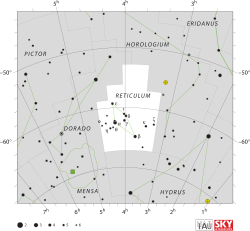Reticulum
| Constellation | |

|
|
| Abbreviation | Ret |
|---|---|
| Genitive | Reticuli |
| Pronunciation |
/rᵻˈtɪkjᵿləm/, genitive /rᵻˈtɪkjᵿlaɪ/ |
| Symbolism | the Reticle |
| Right ascension | 4 |
| Declination | −60 |
| Family | La Caille |
| Quadrant | SQ1 |
| Area | 114 sq. deg. (82nd) |
| Main stars | 4 |
|
Bayer/Flamsteed stars |
11 |
| Stars with planets | 7 |
| Stars brighter than 3.00m | none |
| Stars within 10.00 pc (32.62 ly) | none |
| Brightest star | α Ret (3.33m) |
| Nearest star |
ζ2 Reticuli (39.40 ly, 12.08 pc) |
| Messier objects | none |
| Bordering constellations |
Horologium Dorado Hydrus |
|
Visible at latitudes between +23° and −90°. Best visible at 21:00 (9 p.m.) during the month of January. |
|
Reticulum is a small, faint constellation in the southern sky. Its name is Latin for a small net, or reticle—a net of crosshairs at the focus of a telescope eyepiece that is used to measure star positions. The constellation is best viewed between October and December, but cannot be seen from middle to northern latitudes.
A constellation in this area was introduced by Isaac Habrecht II in his celestial globe in 1621, who named it Rhombus. It was replaced with a somewhat different constellation by the French astronomer Nicolas Louis de Lacaille in the eighteenth century; during his stay at the Cape of Good Hope, he named the constellation le Réticule Rhomboide to commemorate the reticle in his telescope eyepiece. The name was later Latinized to Reticulum in his star catalogue Coelum Australe Stelliferum. In 1810, the stars of Reticulum were used by William Croswell to produce the constellation Marmor Sculptile, which represented the bust of Christopher Columbus, but this did not catch on among astronomers.
The constellation Reticulum became officially recognized during the First General Assembly of the International Astronomical Union in 1922. The boundary for this and other constellations was drawn up by Belgian astronomer Eugène Delporte along arcs of right ascension and declination for epoch 1875. These were published in 1930 in the Delimination Scientifique des Constellations at the behest of the IAU.
Only two of the stars in this constellation are brighter than visual magnitude 5: Alpha (α) and Beta (β) reticuli. The reddish star R Reticuli is a Mira variable. This variable was discovered by C. Ragoonatha Chary at the Madras Observatory in India.
...
Wikipedia
